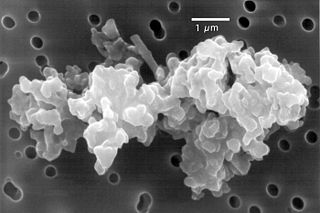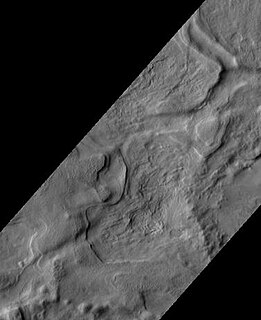
The Dust Bowl was a period of severe dust storms that greatly damaged the ecology and agriculture of the American and Canadian prairies during the 1930s; severe drought and a failure to apply dryland farming methods to prevent the aeolian processes caused the phenomenon. The drought came in three waves: 1934, 1936, and 1939–1940, but some regions of the High Plains experienced drought conditions for as many as eight years.

A dust storm, also called a sandstorm, is a meteorological phenomenon common in arid and semi-arid regions. Dust storms arise when a gust front or other strong wind blows loose sand and dirt from a dry surface. Fine particles are transported by saltation and suspension, a process that moves soil from one place and deposits it in another.
In astronomy, extinction is the absorption and scattering of electromagnetic radiation by dust and gas between an emitting astronomical object and the observer. Interstellar extinction was first documented as such in 1930 by Robert Julius Trumpler. However, its effects had been noted in 1847 by Friedrich Georg Wilhelm von Struve, and its effect on the colors of stars had been observed by a number of individuals who did not connect it with the general presence of galactic dust. For stars that lie near the plane of the Milky Way and are within a few thousand parsecs of the Earth, extinction in the visual band of frequencies is roughly 1.8 magnitudes per kiloparsec.

Cosmic dust, also called extraterrestrial dust or space dust, is dust which exists in outer space, or has fallen on Earth. Most cosmic dust particles measure between a few molecules and 0.1 mm. Larger particles are called meteoroids. Cosmic dust can be further distinguished by its astronomical location: intergalactic dust, interstellar dust, interplanetary dust and circumplanetary dust.

The interplanetary dust cloud, or zodiacal cloud, consists of cosmic dust that pervades the space between planets within planetary systems, such as the Solar System. This system of particles has been studied for many years in order to understand its nature, origin, and relationship to larger bodies.

The Flying Dust First Nation is a Cree First Nation band government located adjacent to the city of Meadow Lake in Saskatchewan, Canada. Highway 55 goes through the band's reserve community.
Circumstellar dust is cosmic dust around a star. It can be in the form of a spherical shell or a disc, e.g. an accretion disk. Circumstellar dust can be responsible for significant extinction and is usually the source of an infrared excess for stars that have it. For some evolved stars on the asymptotic giant branch, the dust is composed of silicate emissions while others contain the presence of other dust components. According to a study, it is still uncertain whether the dust is a result of crystalline silicate or polycyclic aromatic hydrocarbon. However, recent observations revealed that Vega-type stars display broad silicate emission. It is suggested that the circumstellar dust components can depend on the evolutionary stage of a star and is related to the changes in its physical conditions.

Martian soil is the fine regolith found on the surface of Mars. Its properties can differ significantly from those of terrestrial soil, including its toxicity due to the presence of perchlorates. The term Martian soil typically refers to the finer fraction of regolith. So far, no samples have been returned to Earth, the goal of a Mars sample-return mission, but the soil has been studied remotely with the use of Mars rovers and Mars orbiters.

Chasma Boreale is a large canyon in Mars's north polar ice cap in the Mare Boreum quadrangle of Mars at 83° north latitude and 47.1° west longitude. It is about 560 km (350 mi) long and was named after a classical albedo feature name. The canyon's sides reveal layered features within the ice cap that result from seasonal melting and deposition of ice, together with dust deposits from Martian dust storms. Information about the past climate of Mars may eventually be revealed in these layers, just as tree ring patterns and ice core data do on Earth. Both polar caps also display grooved features, probably caused by wind flow patterns. The grooves are also influenced by the amount of dust. The more dust, the darker the surface. The darker the surface, the more melting as dark surfaces absorb more energy.
Dust Beyglu is a village in Dasht Rural District, in the Central District of Meshgin Shahr County, Ardabil Province, Iran. At the 2006 census, its population was 769, in 149 families.

Hirmand County is a county in Sistan va Baluchestan Province in Iran. The capital of the county is Dust Mohammad. It was separated from Zabol in 2007. At the 2006 census, the county's population was 73,254, in 14,677 families. The county is subdivided into two districts: the Central District and Qorqori District. The county has one city: Dust Mohammad.
Dust Mohammad is a town in and the capital of Hirmand County, Sistan and Baluchestan Province, Iran. At the 2006 census, its population was 6,902, in 1,328 families.
Exoplanetary Circumstellar Environments and Disk Explorer(EXCEDE) is a proposed space telescope for NASA's Explorer program to observe circumstellar protoplanetary and debris discs and study planet formation around nearby stars of spectral classes M to B. Had it been selected for development, it was proposed to launch in 2019.
Dust Vand is a village in Baladarband Rural District, in the Central District of Kermanshah County, Kermanshah Province, Iran. At the 2006 census, its population was 298, in 69 families.
Gharib Dust is a village in Barvanan-e Gharbi Rural District, Torkamanchay District, Meyaneh County, East Azerbaijan Province, Iran. At the 2006 census, its population was 381, in 89 families.
Vashnam-e Dust Mohammad is a village in Kambel-e Soleyman Rural District, in the Central District of Chabahar County, Sistan and Baluchestan Province, Iran. At the 2006 census, its population was 52, in 12 families.
Dust Mohammad-e Lashkaran is a village in Dust Mohammad Rural District, in the Central District of Hirmand County, Sistan and Baluchestan Province, Iran. At the 2006 census, its population was 262, in 53 families.
Molla Dust Mohammad is a village in Dust Mohammad Rural District, in the Central District of Hirmand County, Sistan and Baluchestan Province, Iran. At the 2006 census, its population was 133, in 35 families.

Wells is an impact crater in the Eridania quadrangle on Mars. The crater was named after English writer H. G. Wells (1866–1946). The name was approved in 1973, by the International Astronomical Union (IAU) Working Group for Planetary System Nomenclature. Wells is the author of the science-fiction novel The War of the Worlds, depicting an invasion of earth by Martians.

Redi is an impact crater Mars, located in the Hellas quadrangle at 60.6°S latitude and 267.3°W longitude. The crater was named after 17th century Italian physician Francesco Redi. The name was approved by IAU's Working Group for Planetary System Nomenclature in 1973. Redi crater displays dust devil tracks. Part of its floor is covered by a smooth deposit called "latitude dependent mantle."









